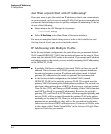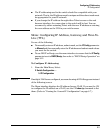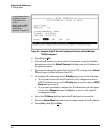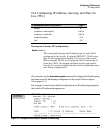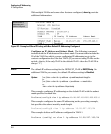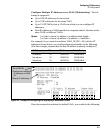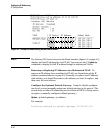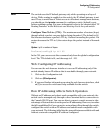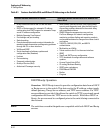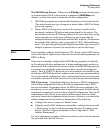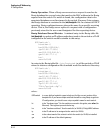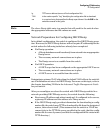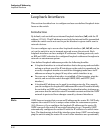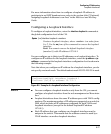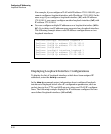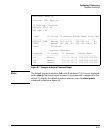
Configuring IP Addressing
IP Configuration
Table 8-1. Features Available With and Without IP Addressing on the Switch
Features Available Without an IP Address Additional Features Available with an IP Address and
Subnet Mask
• Direct-connect access to the CLI and the menu
interface.
• DHCP or Bootp support for automatic IP address
configuration, and DHCP support for automatic Timep
server IP address configuration
• Multiple Spanning Tree Protocol
• Port settings and port trunking
• Switch meshing
• Console-based status and counters information for
monitoring switch operation and diagnosing problems
through the CLI or menu interface.
• VLANs and GVRP
• Serial downloads of software updates and
configuration files (Xmodem)
•Link test
• Port monitoring
• Password authentication
• Quality of Service (QoS)
• Authorized IP manager security
• Web browser interface access, with configuration,
security, and diagnostic tools, plus the Alert Log for
discovering problems detected in the switch along
with suggested solutions
• SNMP network management access such as
ProCurve Manager for network configuration,
monitoring, problem-finding and reporting, analysis,
and recommendations for changes to increase control
and uptime
• TACACS+, RADIUS, SSH, SSL, and 802.1X
authentication
• Multinetting on VLANs
• Telnet access to the CLI or the menu interface
•IGMP
• TimeP and SNTP server configuration
• TFTP download of configurations and software
updates
• Access Control Lists (ACLs)
• IP routing, Multicast Routing
• VRRP router redundancy
• PIM-DM and PIM-SM
• Radius
• Ping test
DHCP/Bootp Operation
Overview. DHCP/Bootp is used to provide configuration data from a DHCP
or Bootp server to the switch. This data can be the IP address, subnet mask,
default gateway, Timep Server address, and TFTP server address. If a TFTP
server address is provided, this allows the switch to TFTP a previously saved
configuration file from the TFTP server to the switch. With either DHCP or
Bootp, the servers must be configured prior to the switch being connected to
the network.
Note The switches covered in this guide are compatible with both DHCP and Bootp
servers.
8-12



